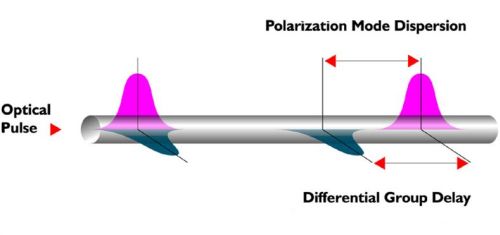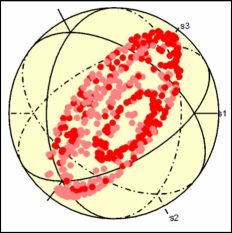| Home |
 |
Polarization Mode Dispersion |
Last Update: 06-Jan-2004 |
Polarization Mode Dispersion (PMD)
Research @ OKT
Light propagating in birefringent materials is subject to different
propagation velocities. If the incident light is polarized along one
of the birefringence axes of the medium it will take longer to pass
the medium than if it were aligned with another axis.
 Silica fibers used in optical communication networks should be
negligibly birefringent, but due to several reasons there is a certain
birefringence, varying along the fiber. A set of orthogonal axes and a
differential group delay (DGD) between them result, which describe the
PMD of the fiber. An optical pulse, polarized along one of these so
called principal axes will be delayed by the corresponding group
delay. For an arbitrary input polarization a pulse with sufficiently
low bandwidth will be split in two pulses at the output, delayed
against each other by the differential group delay. Such a pulse
separation may lead to transmission impairments, especially at bit
rates of 40Gbit/s and above. In an higher order approach, allowing for
pulses with higher bandwidth, the direction of these axes and the
magnitude of the differential group delay become frequency dependent,
leading to additional pulse distortion.
Silica fibers used in optical communication networks should be
negligibly birefringent, but due to several reasons there is a certain
birefringence, varying along the fiber. A set of orthogonal axes and a
differential group delay (DGD) between them result, which describe the
PMD of the fiber. An optical pulse, polarized along one of these so
called principal axes will be delayed by the corresponding group
delay. For an arbitrary input polarization a pulse with sufficiently
low bandwidth will be split in two pulses at the output, delayed
against each other by the differential group delay. Such a pulse
separation may lead to transmission impairments, especially at bit
rates of 40Gbit/s and above. In an higher order approach, allowing for
pulses with higher bandwidth, the direction of these axes and the
magnitude of the differential group delay become frequency dependent,
leading to additional pulse distortion.
To enable high speed transmission in PMD impaired systems, mitigation
measures have to be taken and due to the statistical nature of the
fiberís PMD characteristics adaptive compensation is required.
 Either electronic circuitry can be used to reduce signal distortions
after detection or optical devices in front of the receiver can be
used to compensate for the actual fiber characteristics. Since the
signal processing demands for electronic mitigation increase with
higher transmission rates, thus ultimately limiting the mitigation
capabilities, we concentrate on optical solutions.
Either electronic circuitry can be used to reduce signal distortions
after detection or optical devices in front of the receiver can be
used to compensate for the actual fiber characteristics. Since the
signal processing demands for electronic mitigation increase with
higher transmission rates, thus ultimately limiting the mitigation
capabilities, we concentrate on optical solutions.
An optical PMD compensator consists of a PMD equalizer, a polarization
controller and a feedback loop, using a suitable monitor
signal. Several stages made of equalizer and polarization controller
may be concatenated to compensate for higher order PMD. The PMD
equalizer is a birefringent element of either fixed or variable DGD,
while the polarization controller is used to match the axes of the
equalizer with the principal axes of the fiber. A suitable monitor
signal, basically independent of bit rate and modulation format, is
the degree of polarization (DOP), which is measured using a
polarimeter. The power ratio of polarized light to total incident
light decreases with increasing DGD of the fiber.


 Silica fibers used in optical communication networks should be
negligibly birefringent, but due to several reasons there is a certain
birefringence, varying along the fiber. A set of orthogonal axes and a
differential group delay (DGD) between them result, which describe the
PMD of the fiber. An optical pulse, polarized along one of these so
called principal axes will be delayed by the corresponding group
delay. For an arbitrary input polarization a pulse with sufficiently
low bandwidth will be split in two pulses at the output, delayed
against each other by the differential group delay. Such a pulse
separation may lead to transmission impairments, especially at bit
rates of 40Gbit/s and above. In an higher order approach, allowing for
pulses with higher bandwidth, the direction of these axes and the
magnitude of the differential group delay become frequency dependent,
leading to additional pulse distortion.
Silica fibers used in optical communication networks should be
negligibly birefringent, but due to several reasons there is a certain
birefringence, varying along the fiber. A set of orthogonal axes and a
differential group delay (DGD) between them result, which describe the
PMD of the fiber. An optical pulse, polarized along one of these so
called principal axes will be delayed by the corresponding group
delay. For an arbitrary input polarization a pulse with sufficiently
low bandwidth will be split in two pulses at the output, delayed
against each other by the differential group delay. Such a pulse
separation may lead to transmission impairments, especially at bit
rates of 40Gbit/s and above. In an higher order approach, allowing for
pulses with higher bandwidth, the direction of these axes and the
magnitude of the differential group delay become frequency dependent,
leading to additional pulse distortion.
 Either electronic circuitry can be used to reduce signal distortions
after detection or optical devices in front of the receiver can be
used to compensate for the actual fiber characteristics. Since the
signal processing demands for electronic mitigation increase with
higher transmission rates, thus ultimately limiting the mitigation
capabilities, we concentrate on optical solutions.
Either electronic circuitry can be used to reduce signal distortions
after detection or optical devices in front of the receiver can be
used to compensate for the actual fiber characteristics. Since the
signal processing demands for electronic mitigation increase with
higher transmission rates, thus ultimately limiting the mitigation
capabilities, we concentrate on optical solutions.








 Home
Home  kieckbusch@tu-harburg.de
kieckbusch@tu-harburg.de